Crankshaft and main bearings - removal and refitting
Removal
1 With the engine removed from the vehicle,
remove the timing belt, crankshaft sprocket,
auxiliary shaft sprocket and the
flywheel/driveplate.
2 Remove the pistons and connecting rods. If no work is to be done on the pistons and connecting rods, there is no need to push the pistons out of the cylinder bores.
3 Unbolt the crankshaft front oil seal housing and the auxiliary shaft front cover and remove the gasket.
4 Remove the oil pump and pick-up tube.
5 Check the main bearing caps for identification marks and if necessary use a centre-punch to identify them (see illustration).
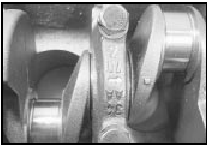
34.5 Main bearing cap identification marks. The arrow points to the front of
the engine
6 Before removing the crankshaft, check that the endfloat is within the specified limits by inserting a feeler blade between the centre crankshaft web and the thrustwashers (see illustration). This will indicate whether or not new thrustwashers are required.
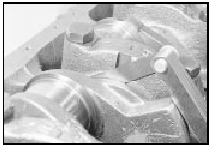
34.6 Checking crankshaft endfloat
7 Unscrew the bolts and tap off the main bearing caps complete with bearing shells. If the thrustwashers are to be re-used identify them for location. Recover the sealing wedges from either side of the rear bearing cap.
8 Lift the crankshaft from the crankcase and remove the rear oil seal. Recover the remaining thrustwashers (see illustration).
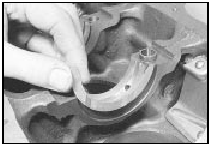
34.8 Removing a thrustwasher from the centre main bearing
9 Extract the bearing shells, keeping them identified for location (see illustration).
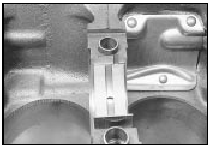
34.9 Extract each main bearing shell
Refitting
10 Commence refitting as follows.
11 Wipe the bearing shell locations in the crankcase with a soft, non-fluffy rag.
12 Wipe the crankshaft journals with a soft, non-fluffy rag.
13 If the old main bearing shells are to be renewed (not to do so is a false economy, unless they are virtually new) fit the five upper halves of the main bearing shells to their location in the crankcase.
14 Identify each main bearing cap and place in order. The number is cast on to the cap and on intermediate caps an arrow is marked which points towards the front of the engine.
15 Wipe each cap bearing shell location with a soft non-fluffy rag.
16 Fit the bearing half shell onto each main bearing cap.
17 Apply a little grease to each side of the centre main bearing so as to retain the thrustwashers.
18 Fit the upper halves of the thrustwashers into their grooves either side of the main bearing. The slots must face outwards.
19 Lubricate the crankshaft journals and the upper and lower main bearing shells with clean engine oil and locate the rear oil seal (with lip lubricated) on the rear of the crankshaft.
20 Carefully lower the crankshaft into the crankcase.
21 Lubricate the crankshaft main bearing journals again, and then fit No 1 bearing cap. Fit the two securing bolts but do not tighten yet.
22 Make sure that the mating faces are clean, then apply sealant (Loctite 518 or equivalent) to the areas on the rear main bearing cap shown (see illustration).
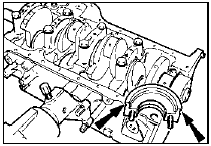
34.22 Coat the arrowed areas of the rear main bearing cap with sealant
23 Fit the rear main bearing cap. Fit the two securing bolts but as before do not tighten yet.
24 Apply a little grease to either side of the centre main bearing cap so as to retain the thrustwashers. Fit the thrustwashers with the tag located in the groove and the slots facing outwards (see illustration).
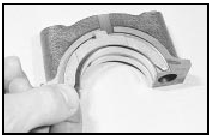
34.24 Fitting a thrustwasher to the centre main bearing cap
25 Fit the centre main bearing cap and the two securing bolts, then refit the intermediate main bearing caps. Make sure that the arrows point towards the front of the engine.
26 Lightly tighten all main bearing cap securing bolts and then fully tighten in a progressive manner to the specified torque wrench setting.
27 Check that the crankshaft rotates freely.
Some stiffness is to be expected with new components, but there must be no tight spots or binding.
28 Check that the crankshaft endfloat is within the specified limits by inserting a feeler blade between the centre crankshaft web and the thrustwashers.
29 Make sure that the rear oil seal is fully located onto its seating. Coat the rear main bearing cap sealing wedges with sealing compound, then press them into position using a blunt screwdriver with the rounded red face towards the cap (see illustration).
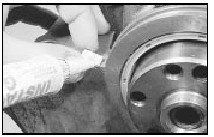
34.29 Fitting a sealing wedge to the rear main bearing cap
30 Refit the oil pump and pick-up tube.
31 Refit the crankshaft front oil seal housing and the auxiliary shaft front cover using a new gasket, and tighten the securing bolts. Smear the lip of the oil seal with clean engine oil before fitting; and using a straight edge, ensure that the bottom face of the oil seal housing is aligned with the bottom face of the cylinder block before finally tightening the bolts.
32 Refit the pistons and connecting rods.
33 Refit the flywheel/driveplate and the auxiliary shaft sprocket, crankshaft sprocket, and timing belt.
See also:
Throttle cable - adjustment, removal and refitting
Adjustment
1 Disconnect the battery earth lead.
2 On manual transmission models remove
the air cleaner unit, as given in Section 2.
3 Get an assistant to sit in the driving seat
and fully depress ...
Speedometer cable - removal and refitting
Removal
1 Disconnect the battery and remove the
instrument panel as described in Section 9.
2 Disconnect the cable from the transmission
and release it from its clips and grommet.
3 Withdraw the ...
Knock sensor - removal and refitting
Removal
1 The knock sensor is screwed into the
cylinder block, near the oil filter (see
illustration).
15.1 Knock sensor location - 1.4 CFI engine
A Knock sensor
B Wiring plug
C Securing bolt ...
